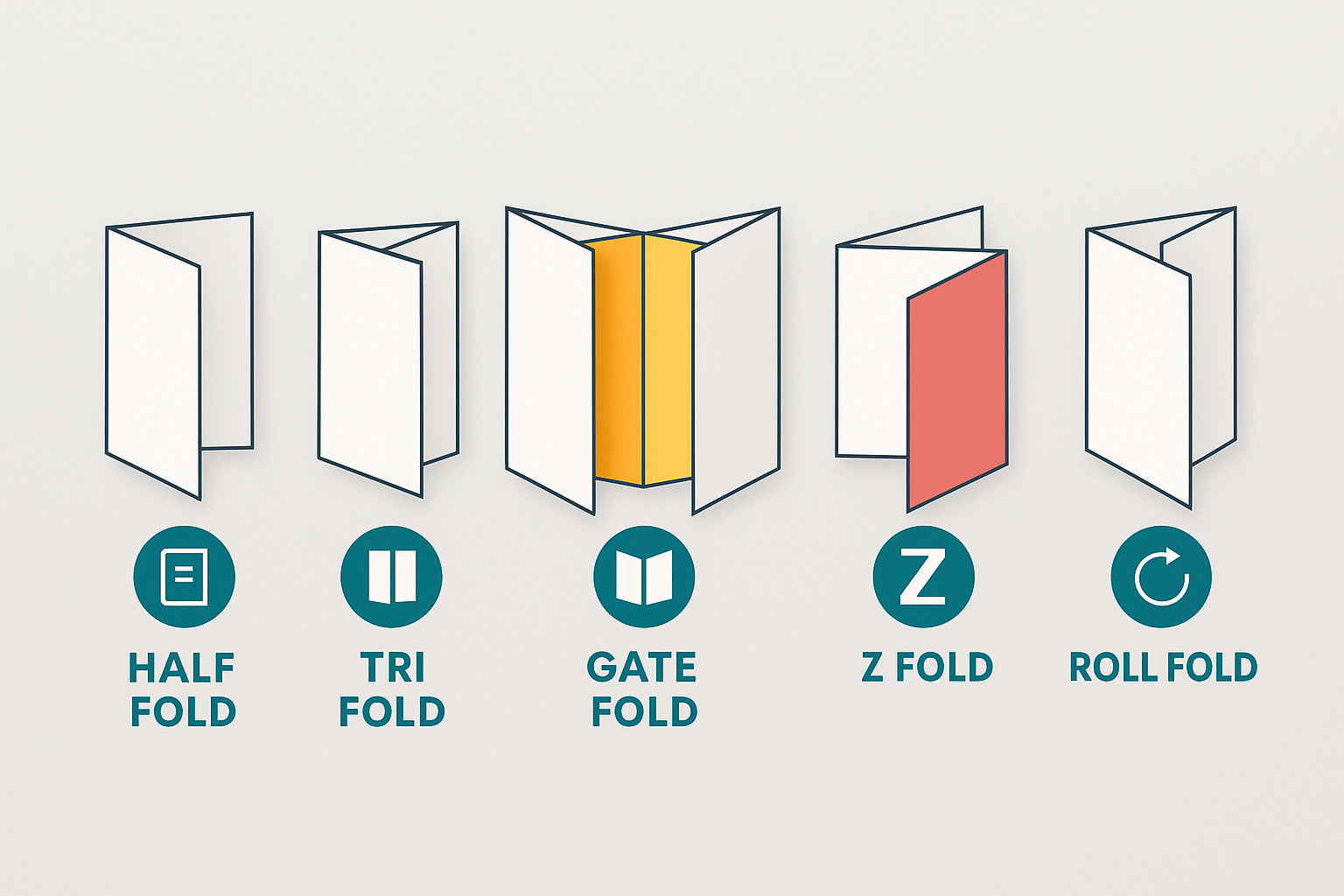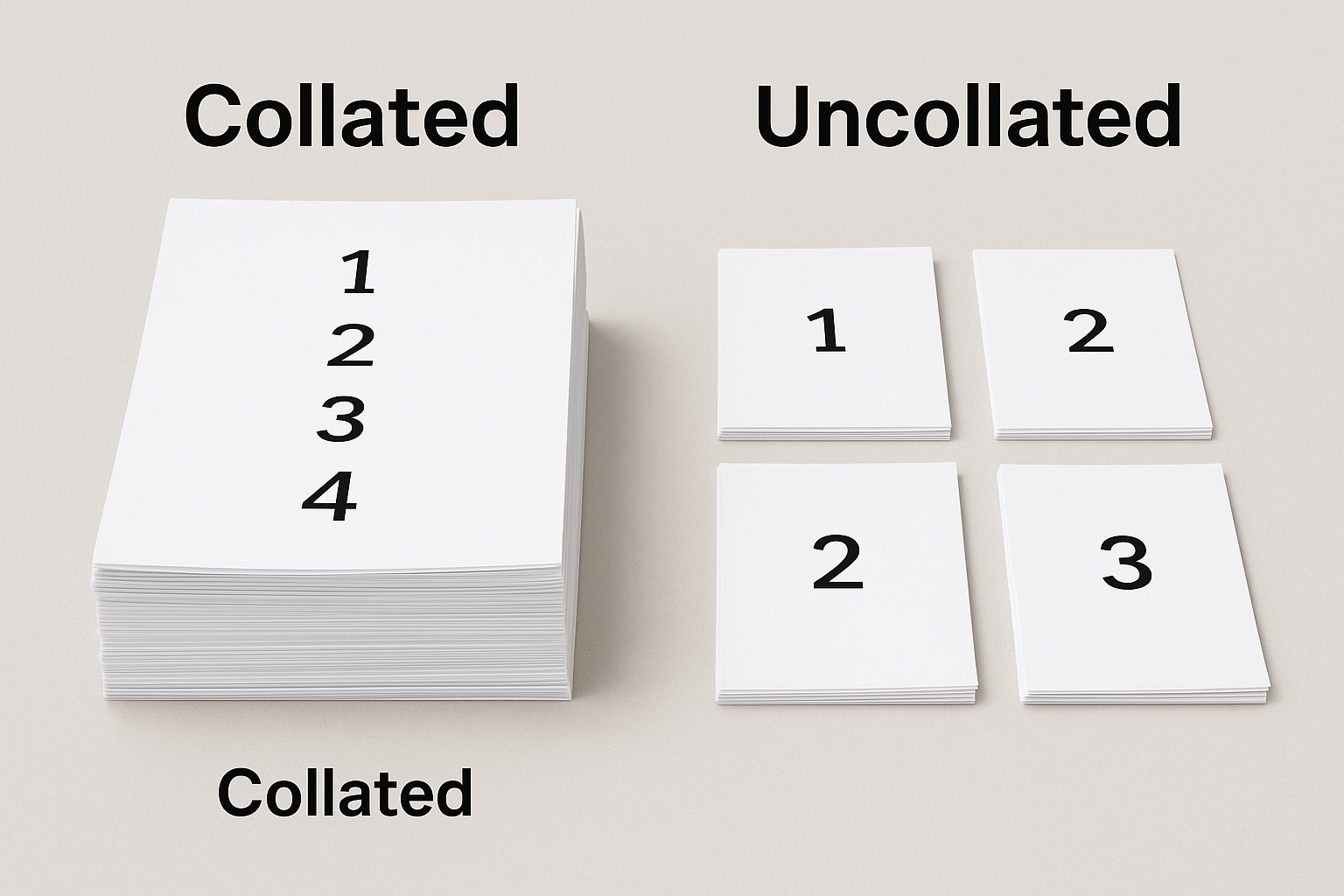Most Popular Types of Brochures and Brochure Folding Options: From Half Fold to Z Fold
Brochures are versatile marketing tools designed to present information clearly, concisely, and attractively. Whether you’re announcing a product, outlining services, or directing foot traffic at an event, the way a brochure folds dramatically shapes how your message is received. This guide dives into the most common brochure types, explains the logic behind each fold, and helps marketers, designers, and business owners choose the right layout for their goals. Whether you’re here for a quick answer or looking to level up your design knowledge, you’ll find what you need below.
Types of Brochures at a Glance
Choosing the correct brochure type can significantly enhance your marketing effectiveness. Different folds cater to specific messaging needs and audience interactions, making it crucial to align your brochure format with your communication goals. Before diving into individual folds, here is a comparative overview of standard brochure types. This table summarizes key attributes so you can scan quickly and find formats that suit your project.
| Brochure Type | Panel Count | Ideal Page Size | Best Use Case |
| Half Fold | 2 | 8.5″ x 11″ | Menus, programs, product sheets |
| Tri Fold | 3 | 8.5″ x 11″ | Travel guides, service brochures |
| Z Fold | 3 | 8.5″ x 11″ | Event schedules, floor plans |
| Gate Fold | 4 | 8.5″ x 14″ | Portfolios, event invitations |
| Double Gate Fold | 8 | 11″ x 17″ | Premium product showcases |
| Accordion Fold | 4–6 | 8.5″ x 14″ or longer | Step-by-step guides, timelines |
| Roll Fold | 4+ | 8.5″ x 14″ or longer | Instruction manuals, wellness menus |
| French Fold | 4 | 8.5″ x 11″ or larger | Event maps, high-end invites |
| Double Parallel | 8 | 11″ x 17″ | Conference agendas, product features |
| Single Flat | 1 | Any standard size | Handouts, flyers, inserts |
Half Fold Brochure
A Half Fold brochure is created by folding a sheet of paper in half, resulting in two large panels. This format is ideal for concise presentations such as restaurant menus, event programs, or brief product overviews. Its simple layout allows for a bold cover image or headline on the front panel and supporting details on the back. Use 80–100 lb gloss or matte text stock for vibrant color reproduction and durability. When laying out content, maintain at least a 0.125-inch margin from the fold line to prevent important text or images from being cut off.
Tri Fold Brochure
Tri Fold brochures divide a single sheet into three equal panels, creating six sections for sequential content. This versatile format is popular for travel guides, service menus, and nonprofit promotions due to its organized, easy-to-follow structure. A typical layout features an attention-grabbing cover on the front panel, detailed content across the interior panels, and a clear call-to-action or contact details on the back panel. Designers should print on 80 lb gloss text for cost efficiency or 100 lb matte cover for a premium feel. Adjust interior panel widths by approximately 1/32 inch to ensure clean folds without bulging.
Z Fold Brochure
Z Fold brochures consist of three panels folded in a zig-zag or “Z” pattern, creating a continuous, linear reveal. This layout is ideal for timelines, step-by-step guides, and panoramic images that span multiple panels. The open design allows readers to absorb content from left to right in a logical flow. Designers should use 80 lb gloss text or 100 lb silk cover stock and include a 1/16-inch trim allowance on each panel to prevent misalignment. Ensure that critical images and text do not align exactly on fold lines to avoid registration issues during printing.
Gate Fold Brochure
Gate Fold brochures feature two narrow outer panels that fold inward to meet at the center, revealing a large interior spread. This format creates a dramatic unveiling effect, making it perfect for high-end portfolios, luxury product presentations, and event invitations. Designers should use 100 lb matte or silk cover stock for rigidity and durability, and score both fold lines to prevent paper cracking. Place teaser images or engaging headlines on the outer panels to build anticipation, reserving the center spread for bold visuals or key messaging that captivates the audience.
Double Gate Fold Brochure
A Double Gate Fold brochure adds an additional interior fold to the Gate Fold format, resulting in eight panels total. This expanded structure is ideal for premium catalogs, comprehensive product showcases, and multi-section brand stories. Use 100–120 lb matte cover stock for strength, and ensure precise scoring to maintain alignment across folds. Designers should keep consistent margins of at least 0.125 inches from each fold and employ a unifying visual theme across all panels. This format offers ample space for detailed content while preserving the dramatic reveal of a standard Gate Fold.
Accordion Fold Brochure
Accordion Fold brochures are created by folding a sheet back and forth in alternating directions, forming 4–6 panels. This style is well-suited for step-by-step instructions, event itineraries, and educational materials, as it allows a continuous narrative flow across multiple panels. Designers can print on 80 lb gloss or 100 lb matte text stock and use a light aqueous coating to protect high-touch areas. Numbering panels and incorporating directional arrows can guide readers through longer formats, ensuring they follow the intended sequence without confusion.
Roll Fold Brochure
Roll Fold brochures wrap panels inward in a rolling sequence, making them ideal for dense informational content such as spa menus, service protocols, and instructional booklets. Each subsequent panel must be slightly narrower—about 1–2 mm—than the preceding one to fold smoothly without buckling. Designers should use 80–100 lb gloss or matte text stock and apply a light aqueous coating to protect frequently handled sections. Begin with a compelling headline on the front panel to encourage unfolding, and consider numbering each panel to maintain reading order for the audience.
French Fold Brochure
French Fold brochures are created by folding a sheet in half horizontally, then vertically, resulting in a compact, four-panel layout that opens into a small poster-like spread. This format is ideal for event maps, special announcements, and pocket-sized guides. Designers should use 80–100 lb text stock with a matte finish to minimize glare and ensure smooth unfolding. Key graphics should remain centered within interior panels to avoid split visuals. Including directional cues such as “Open Here” helps guide users through the unfolding process.
Double Parallel Fold Brochure
Double Parallel Fold brochures involve folding a sheet in half lengthwise, then folding it in half again in the same direction, resulting in eight slim, stacked panels. This layout works well for segmented content such as conference agendas, technical specifications, and multi-part training materials. Designers should print on 80–100 lb gloss text or 100–120 lb matte cover stock, using consistent scoring for precise alignment. Clear headers and consistent branding across all panels help maintain visual continuity and prevent reader disorientation.
Single Flat Brochure
A Single Flat brochure is a standalone, unfolded sheet—commonly used as a flyer, insert, or promotional handout. Because there are no folds, every design element must immediately capture attention. Place bold headlines and strong imagery at the top, and use 100–130 lb cover stock for durability, with UV or aqueous coatings for added protection. Designers should establish a clear visual hierarchy—headline, subheadline, body text, and call-to-action—to guide readers through information at a glance. Consider die-cut shapes or custom sizes to make the Single Flat stand out in competitive settings.
How Do You Fold a Brochure Step by Step
Whether you’re folding by hand or using a machine, these steps ensure crisp, professional results:
- Score the sheet with a bone folder to avoid cracking.
- Align the paper edges on a cutting mat.
- Fold the lightest panels first to reduce stress on thick folds.
- Press down using a ruler or clean edge for sharp creases.
- Stack finished brochures under a weight to flatten.
Machine folding suits large runs, while hand folding works for custom jobs. Avoid common mistakes like folding against the grain or using ink-heavy designs without scoring.
How to Choose the Right Brochure Format for Your Audience
Begin by defining the brochure’s purpose: are you promoting a product, informing an audience, or directing traffic at an event? Then, assess how much content you need. Use Tri Folds for quick overviews, Gate Folds for drama, Z Folds for processes, and Accordions for step-by-step layouts.
Match the fold to the user’s behavior: a hurried passerby appreciates a quick tri-fold; a luxury shopper expects a tactile gate fold. Here’s a quick checklist to help marketers narrow down:
- What’s your message?
- Who is your audience?
- Where will it be distributed?
- How long should the reader engage?
Design and Copy Tips for Any Brochure Type
Keep designs clean and communicative:
- Limit to 1–2 fonts.
- Use bold colors for CTAs.
- Maintain a 0.125-inch bleed on all sides.
- Align text with fold lines to avoid split messaging.
Pair panel sizes with ideal word counts: ~75–100 words per small panel, 150–200 on large spreads. Use accessible fonts (min. 10pt), avoid red-on-black text, and test prints for legibility. Triboro Printing can help optimize designs for visual and physical readability.
Paper Choice, Coating, and Sustainable Printing
Paper selection affects both feel and foldability—and also plays a role in how professional and polished your final product appears. For cost-effective mass distribution, 80 lb gloss text is a top choice due to its smooth surface and vibrant ink absorption. For premium projects such as Gate or Double Gate folds, opt for 100 lb matte or silk cover stock, which offers rigidity and a luxurious feel.
Coatings further enhance the look and performance. Aqueous coating (AQ) is common for basic protection and sheen. UV coating adds high gloss and durability but can crack on tight folds if not scored. Soft-touch coatings deliver a velvety texture ideal for upscale branding.
Triboro Printing helps clients match stock and coating combinations to brochure format to avoid issues like paper curl or ink flaking. For instance, thicker stocks hold fold lines cleaner but may require scoring; glossy papers are eye-catching but highlight fingerprints.
For eco-conscious brands, Triboro Printing also provides:
- Soy- and vegetable-based inks for cleaner production.
- FSC-certified or post-consumer recycled papers.
- Digital short-run options to minimize overproduction and reduce waste.
These sustainable solutions lower environmental impact without compromising quality—an increasingly valuable consideration for modern audiences.
Frequently Asked Questions on Brochure Types
- What’s the difference between a Tri Fold and Z Fold? Tri Folds nest panels; Z Folds open in a linear zig-zag.
- What fold is best for direct mail? Tri Fold or Z Fold fit standard envelopes and mail well.
- Which fold is cheapest to print? Single Flat or Half Fold—minimal cutting and folding required.
- How many panels before folds start jamming? 8+ panels require scoring or machine folding to avoid issues.
- Can I design across multiple panels? Yes, but align artwork carefully—especially on Z or Accordion folds.
- Do thicker coatings crack? Yes—especially UV gloss on tight folds. Always test print.
Choosing the right brochure type is a blend of purpose, audience, and design strategy. Whether you’re creating a simple Half Fold menu or a Double Gate Fold product teaser, understanding these mechanics puts you in control of the message. Bookmark our comparison table or download a fold template to test layouts. When in doubt, contact Triboro Printing for expert consultation and mock-ups—bringing your design from screen to print with precision. In a digital age, nothing makes a message stick like something you can hold.




Post a Comment